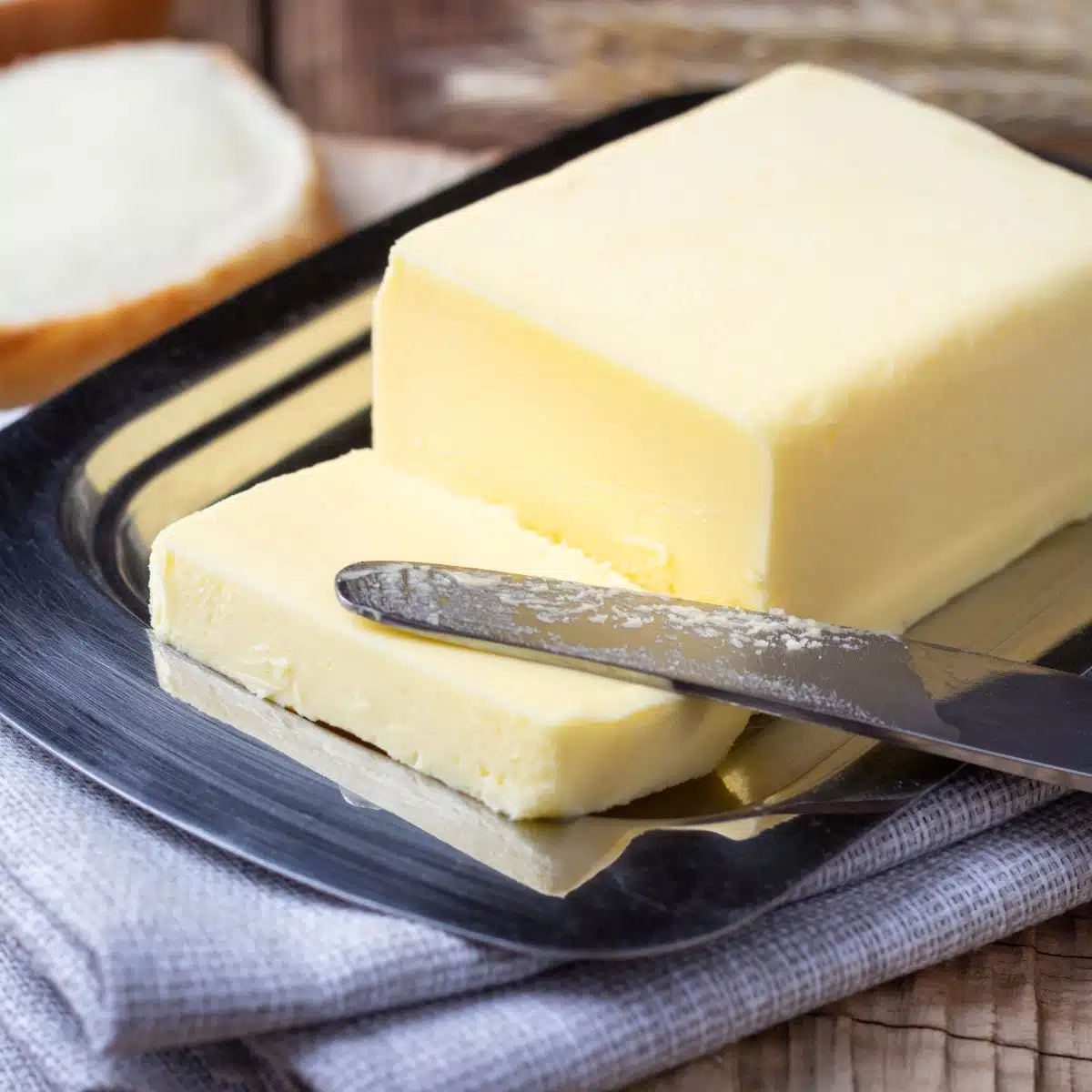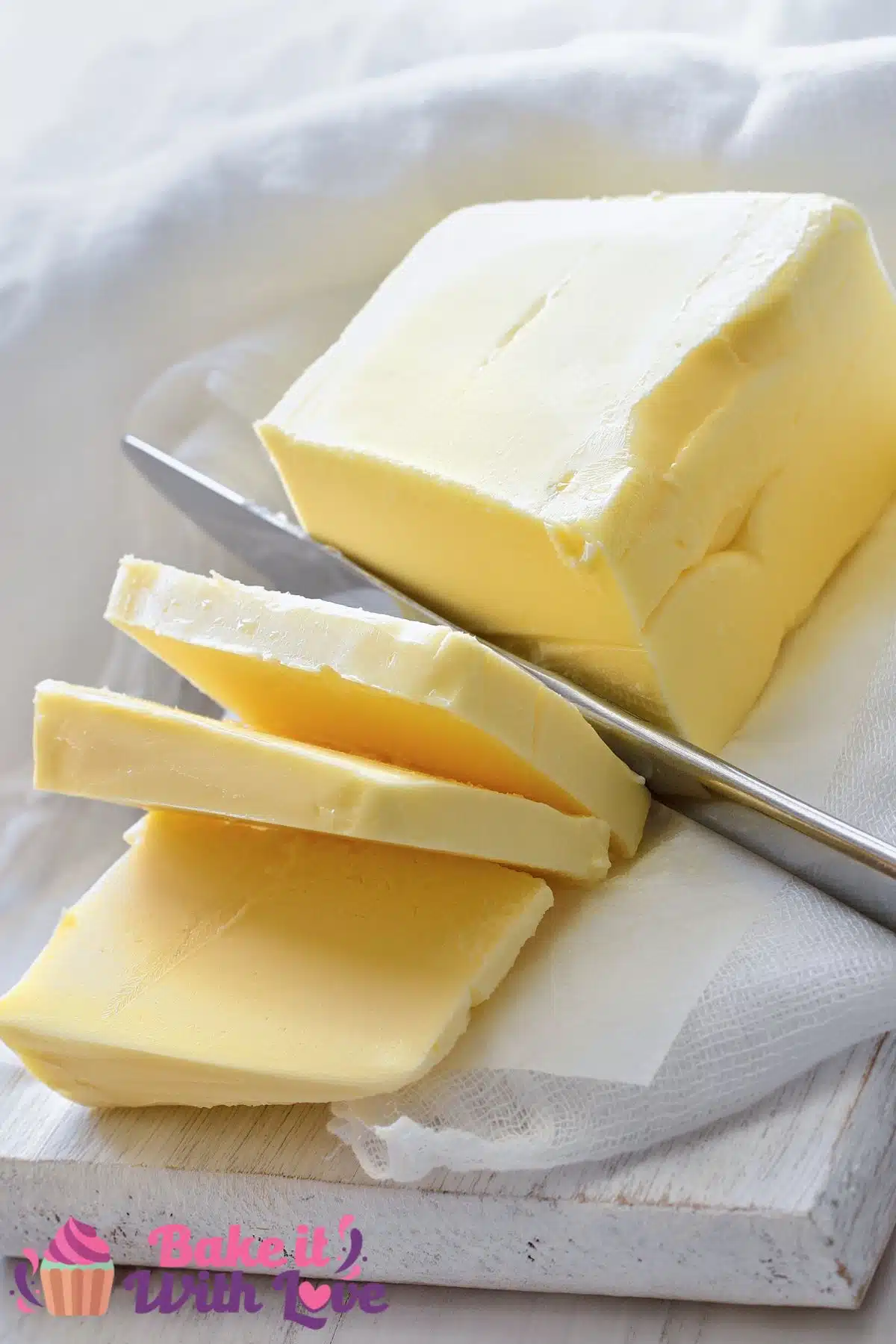Learn how to soften butter so that you can bake all of your favorite treats that need room-temperature butter! Not only will I show you the best way to ensure perfectly softened butter, but I will also let you know why it is so important! Here are all the best tips and tricks to soften your butter (even if you forgot to take it out of the fridge!)
Guide To Room Temperature Butter
If you've ever been getting ready to make some cookies (or cake, or buttercream, etc) and you realize that you've forgotten to take the butter out of the fridge- we've all been there. Does the butter really need to be at room temperature? Can't you just pop it in the microwave? Does it matter if it is melted?
Let me just tell you that, yes, it does matter. However, there are some easy solutions to get your butter to that ideal temperature even if you forgot to take it out of the fridge in time!

Jump to:
- Guide To Room Temperature Butter
- What Does Softened To Room Temperature Mean
- Why Room Temperature Butter Matters
- Methods To Soften Butter
- How To Soften Butter On The Counter
- How To Soften Butter In The Microwave
- How To Soften Butter In A Double Boiler
- How To Soften Butter With A Glass
- How To Soften Butter With A Rolling Pin
- How To Test When Butter Is Ready
- When To Use Chilled Or Melted Butter
- 🍪 Sweet Treats To Try
- 📖 Recipe Card
- 💬 Comments & Reviews
What Does Softened To Room Temperature Mean
Have you ever looked at a recipe and seen that it calls for butter that is "softened to room temperature?" What exactly does that mean?
When butter is at room temperature, it is cool to the touch but can easily be dented with your finger. It is not melted or dripping, and not hard as a rock either.
Why Room Temperature Butter Matters
A ton of different baking recipes call for room-temperature butter. It is an important element when you want to cream together your butter and sugar (which is common in many recipes!)
Butter has some unique qualities that other saturated fats don't have. While it is a solid at room temperature, it is also capable of being whipped and holding air.
When you cream together your butter and sugar, the coarse sugar crystals actually cut small pockets into the butter which then trap air. This process of aeration ensures a final result that is light, fluffy, and tender.
If you use butter that is cold and straight from the fridge, it is too hard for the sugar crystals to form the air pockets. Your baked goods could easily become clumpy or bake unevenly.
At the other end of the spectrum, using melted butter will cause your batter or dough to be too runny and your cookies (or other baked goods) will be flat.
Methods To Soften Butter
The best method for softening butter is to simply take it out of the fridge 30 minutes before you intend to start baking. Just set it on the kitchen counter and it will be ready to use when you get started.
Of course, we can get busy and easily forget to take the butter out of the fridge. Don't worry, here are a few other ways you can bring the butter to the proper temperature (as well as some tips and tricks to speed up the process!)
How To Soften Butter On The Counter
Softening butter on the counter is the ideal method for bringing it up to room temperature! You can simply set the whole stick of butter on the counter and wait, or you can try this method to speed up the process!
- Cube. If desired, cut your stick of butter into cubes to speed up the process.
- Preheat. Preheat your oven to the desired temperature for your recipe.
- Place. Place your cubed (or whole) stick of butter on a plate next to the warming oven.
- Use. The butter is ready to use when it reaches your desired temperature.

How To Soften Butter In The Microwave
Using the microwave is the quickest way to get your butter to your desired temperature, but it is also the easiest to mess up (and wind up with a pool of melted butter).
You'll want to heat your butter using only increments of 2-5 seconds on the lowest power setting. Yes, it is a little tedious, but it is still quicker than waiting for butter to come up to temperature naturally.
Remember to keep an eye on your butter because you don't want it to melt!
How To Soften Butter In A Double Boiler
- Simmer. Put a pot of water on the stovetop and bring it to a simmer (not a boil) and then take it off of the heat.
- Cut. Take your butter out of the fridge and cut it into cubes.
- Warm. Place the cubed butter into a glass bowl and set it over the hot pot.
- Remove. Remove the butter from the pot when it reaches your desired temperature.
How To Soften Butter With A Glass
- Fill. Fill a microwave-safe glass with water (make sure to use a glass that is tall enough to fit over a stick of butter).
- Heat. Heat the glass in the microwave for one minute.
- Dump. Carefully remove the glass from the microwave and dump out the water.
- Place. Immediately place the glass over the stick of butter.
- Sit. Let the glass sit over the butter for 5 minutes.
- Remove. Remove the glass and let the butter continue to sit on the counter for an additional 10 minutes before using.
How To Soften Butter With A Rolling Pin
Finally, you can use this method for practically instant results so you can go ahead and start baking right away!
- Remove. Bring your cold butter out of the refrigerator.
- Place. Set the stick of butter between two pieces of parchment paper (or wax paper).
- Roll. Use a rolling pin to slightly smush the butter into a flattened shape, and then roll it out into a sheet. *Alternatively, you can use a mallet or rolling pin to pound the butter into a flattened shape or grate it with a cheese grater.
- Use. Once the butter is rolled out (or grated), it is ready to use.
How To Test When Butter Is Ready
The easiest way to check if your butter is properly softened is by using the fingerprint test. Simply press your finger onto your stick of butter. Ideally, your finger should make an indention without sliding around.
If your finger is greasy or pressing straight `through the stick, then your butter is too soft and should go back into the fridge for a few minutes.
You could also check your butter with a thermometer. Room-temperature butter should have an internal temperature between 65-67°F (18-19°C).
When To Use Chilled Or Melted Butter
Room-temperature butter is not the only correct way to use butter. There are times when it is necessary to use chilled or melted butter as well!
Pie crusts and pastries typically use cold butter straight from the fridge (which is what causes those delicious and flaky layers!) On the other hand, melted butter does a great job at holding together mixtures (like a graham cracker crust) or for use in chewy cookie bars!
Now that you know how to properly (and easily) bring your butter to room temperature, which method is your favorite? Leave a comment down below and let me know what you think!
>>>>See all of my recipes here<<<<

🍪 Sweet Treats To Try
- Red Velvet Blossoms - These tender and chewy red velvet cookies are topped off with a chocolate Hershey's kiss!
- Edible Cookie Dough - Leave the oven off and enjoy some completely safe homemade cookie dough straight from the bowl!
- Chocolate Chip Cookie Dough Buttercream - This irresistible frosting will taste fantastic on cakes, cookies, and cupcakes!
- Oreo Dump Cake - A rich and decadent dessert that is ready to enjoy with minimal effort!
- Fudge Brownies - Classic fudge brownies are a sweet treat that is great for any time of the year!
- Cowboy Cookies - These cookies are loaded with all of your favorite treats and flavors!
Do you love a recipe you tried? Please leave a 5-star 🌟rating in the recipe card below and/or a review in the comments section further down the page.
Stay in touch with me through social media @ Pinterest, Facebook, Instagram, or Twitter! Subscribe to the newsletter today (no spam, I promise)! Don't forget to tag me when you try one of my recipes!
📖 Recipe Card
How To Soften Butter
Ingredients
- 1 stick butter
- 1 large glass (microwave safe)
(Note: 2x or 3x only changes the ingredient list)
Instructions
Soften Butter In The Microwave
- Place your cold butter onto a microwave-safe dish.
- Microwave using the lowest power setting, in very short bursts of 2-5 seconds.
- Check the butter after each session to ensure it isn't melted and is at the proper temperature.
Soften Butter In A Double Boiler
- Place a pot of water on the stovetop over medium-low heat.
- Bring the water to a simmer and then remove it from the heat.
- Cube your cold butter and place it into a glass bowl.
- Set the glass bowl over the top of the heated pot of water.
- Remove the butter when it reaches your desired temperature.
Soften Butter With A Glass
- Fill a microwave-safe glass with water (make sure to use a glass that is tall enough to fit over a stick of butter).
- Heat the glass in the microwave for one minute.
- Carefully remove the glass from the microwave and dump out the water.
- Immediately place the glass over the stick of butter.
- Let the glass sit over the butter for 5 minutes.
- Remove the glass and let the butter continue to sit on the counter for an additional 10 minutes before using.
Soften Butter On The Counter
- If desired, cut your stick of butter into cubes to speed up the process.
- Preheat your oven to the desired temperature for your recipe.
- Place your cubed (or whole) stick of butter on a plate next to the warming oven.
- The butter is ready to use when it reaches your desired temperature.
Soften Butter With A Rolling Pin
- Bring your cold butter out of the refrigerator.
- Set the stick of butter between two pieces of parchment paper (or wax paper).
- Use a rolling pin to slightly smush the butter into a flattened shape, and then roll it out into a sheet. *Alternatively, you can use a mallet or rolling pin to pound the butter into a flattened shape or use a cheese grater to grate the butter.
- Once the butter is rolled out (or grated), it is ready to use.
Notes
- Remember to keep an eye on your butter so that it doesn't become too soft or melt!
- You can easily cube your butter to speed up the process.



catalina says
This worked exactly as written, thanks!